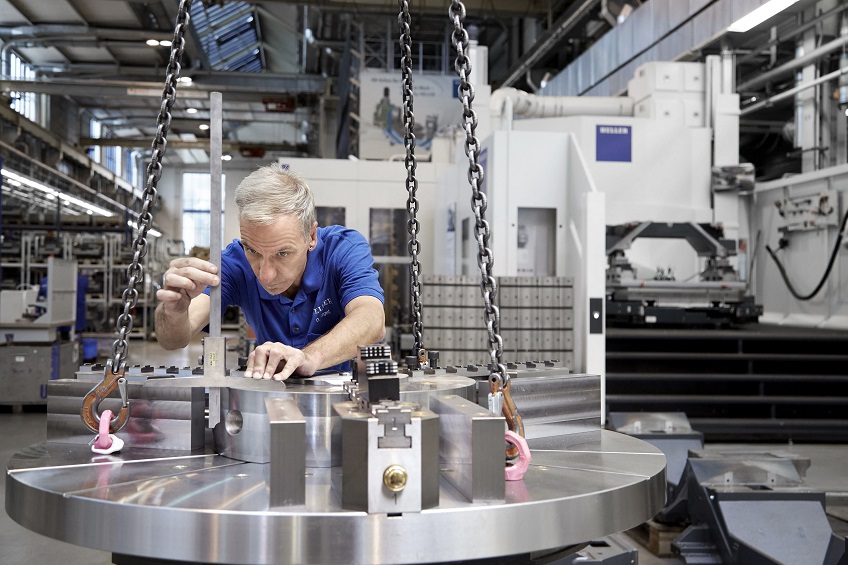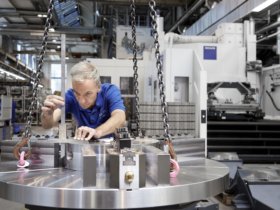Supply chains – From endurance test to new alliances
The reliability of supply chains has become one of the major topics of discussion since the beginning of the corona pandemic. Some organisations are struggling to procure masks and vaccines, others are having to contend with suppliers with furloughed employees or disruptions in the raw materials market. And major imponderables such as trade conflicts and political influence hover over everything. Are all of these factors triggering a trend towards deglobalisation? Are there emerging signs of a preference for domestic sourcing, i.e. searching for suppliers in the domestic market? In the machine tool industry, the question of value chain resilience is likely to be closely linked to digitalisation and networking – topics that will also feature prominently at METAV digital from 23 to 26 March.

Back in spring 2020, a study by the Technical University of Munich attracted attention. It concluded that the global supply chain structures are set to “change dramatically” in the future. It stated the importance of having alternative suppliers in regions which have suffered little impact, and of being able to fall back on these in future crises. But the VDW (German Machine Tool Builders’ Association), Frankfurt am Main, believes that its own industry is under far less pressure to act than the chemical or pharmaceutical industries, for example.
Strong position thanks to high vertical integration
Dr. Wilfried Schäfer, Executive Director of the VDW, cites the industry’s high quality standards as the main reason: “The companies either have very high vertical integration or they are already buying predominantly in Germany.” There have been shortfalls in deliveries of components and raw materials from China or southern Europe, but also possibilities to compensate for these in the form of alternative suppliers.
Benjamin Eichinger of Würzburg-based Scoutbee agrees: “Yes, there are shocks that hit companies, but there are also tools that can help.” Scoutbee specialises in searching for digital suppliers. The company uses artificial intelligence (AI) and big data to help its customers search for products and suitable suppliers in billions of data sets using a SaaS (Software as a Service) solution. Detailed market information – including financial figures, sustainability reports and active certification – is mined across different languages and in real time to identify all current and potential suppliers worldwide. According to Eichinger, a manual search usually takes weeks or months, whereas its digital equivalent takes days at most. Based on customer experience, this yields an average time saving of 85 per cent.
Scoutbee saw a surge in orders and customers in 2020, including machine tool manufacturers. Founded in 2015 and only having begun trading two years ago, the company now has a staff of over 130. It has already booked a virtual stand at the METAV digital 2021 trade fair which is set to take place from 23 to 26 March 2021. Eichinger confirms a noticeable preference for “local” suppliers in recent times. Global strategies have also been scaled back. But the search for new suppliers was not necessarily triggered by corona. Poor quality and a desire for lower delivery costs are also contributing to the changes.
Involving suppliers in the planning
Being prepared for surprises and possible failures is all part of the business for machine tool manufacturers. “Basically, nothing has changed in our purchasing strategy,” says Manfred Maier, Chief Operating Officer (COO) of the Heller Group in Nürtingen when asked about possible consequences of the corona pandemic. The Heller Group develops and produces CNC machine tools and manufacturing systems for machining. “We continue to rely on the high quality and reliability of our suppliers, most of which are European,” emphasises the COO. Maier concedes, however, that they are increasingly shifting parts of the value chain to low-wage countries in order to leverage cost benefits. Heller sources iron castings from Asia for the same reason. He does not see a problem in this: “In general, the goal is to have a dual or even, in some product groups, a multiple sourcing strategy. One reason for this could be the complexity of the assemblies.”
According to Maier, overall material supply levels remained very high in 2020, despite a significant number of suppliers furloughing their staff. “We included critical suppliers early on in our forecast planning. These forecasts are updated every month.” This allows suppliers to adjust to fluctuations in demand from an early stage and guarantees a steady supply of materials. All strategic and operational buyers are urged to keep their “ear to the ground” in order to anticipate critical developments. Questions are asked “tactfully and sensitively” in daily meetings, Maier emphasises. The QKZ (quality score) ratio, which combines supplier reliability and complaints in a single figure, provides information on the quality of suppliers. The data is taken from the SAP system.
SMEs rely on trust-based cooperation
An industry’s structure plays a role in determining its preferred type of supplier relationship. This fact was revealed in a study by the Fraunhofer Working Group for Supply Chain Services, Nuremberg, on value chains in the automation industry. This found that small and medium-sized enterprises (SMEs) tend to search regionally for the products and services they need. They prefer to rely on long-term and trust-based partnerships. Large companies, by contrast, tend to procure the goods they need globally, finding ways through complex structures, generating validatable metrics and planning forward-looking control mechanisms.
The study also proved that as automation levels increase, SMEs, too, are finding it difficult to cope with the growing complexity of supply relationships. The simple “order-to-payment process” of earlier times, which only took place within a single company but could be joined together in chains across multiple companies, has now developed into a complex network. Machines, conveyors, robots, controls and software components are linked and connected to the marketing, sales and distribution processes. Business success is also increasingly dependent on accompanying services over the entire life cycle of a solution, including (remote) maintenance, repairs and disposal. External experts and specialists often have to be called in for this. The whole system is then greatly augmented in the digital world by cyber-physical systems (CPS), i.e. systems which combine information and software technology with mechanical components.
Customers as drivers of complexity
However, according to Andreas Gützlaff, Head of Production Management in the WZL machine tool laboratory at RWTH Aachen University, the greatest driver of complexity is often the customer. Specific customer demands can require greater numbers of product variants, leading in turn to more complex product portfolios and directly impacting design, planning, supply chain, production and distribution. The resulting complexity requires transparency and a new kind of data management, says Gützlaff. Ultimately, it is all down to the simple but crucial question: “Where am I making money and where am I losing it?”
According to the WZL’s findings, complex value creation networks may harbour (cost) risks, yet also hold the promise of achievable efficiency gains. “Managed complexity can yield savings of up to 15 per cent in the operating result,” emphasises Gützlaff. This is backed up by experience from the companies with which the WGP Institute WZL cooperates.
In order to meet the demand for suitable solutions, the WZL, in cooperation with the Complexity Management Academy and the University of St. Gallen, will run the “Plant Complexity” focus group from next year, in which companies can exchange ideas with experts and other companies and find possible solutions. The offer applies across all sectors and is aimed at managers from production and the supply chain.
Focus on process chains at METAV digital 2021
Representing the entire metalworking process chain is traditionally one of the main focuses of METAV. Industry 4.0, including aspects such as networked manufacturing, cloud applications, data management, cybersecurity and the platform economy, has been gaining in importance at recent trade fairs. The upcoming METAV digital could also provide a boost for this area, as the platform offers its participants excellent networking opportunities. The VDW, as organiser, is therefore expecting companies increasingly to use the METAV digital for establishing new business connections and forging strong new alliances on their virtual trade fair stands.
10.019 characters
Author: Cornelia Gewiehs, freelance journalist, Rotenburg (Wümme)
Downloads
Documents
Pictures






